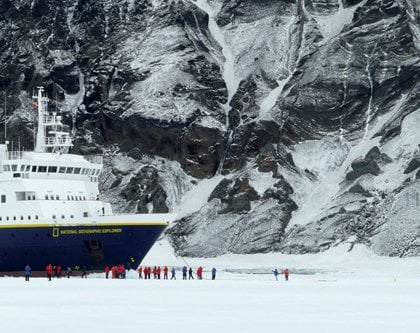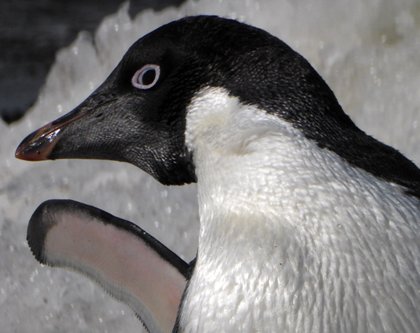
Parked in the ice adjacent to Beak Island, Duse Bay.

Adélie penguin, Devil Island.
Random flakes of snow flew from the ragged edges of steel gray clouds. Rapidly they lost their lacy arms, becoming pellets, firm and round, accumulating on decks and painting the patterned flanks of Beak Island. Ice crystals defined the ripples on the charcoal sea and aggregated rapidly into disks and polygons.
Effortlessly the ship pushed her way into the solid apron of ice that stretched away from the Tabarin Peninsula to the adjacent islands of Duse Bay. Fractures split the edges into blocks and fissures on our port. But the starboard held, thick, solid and rigid. We spilled from the cargo doors and played upon the ice, promenading round the orange cone periphery of our plaza or tugging upon the mooring line.
Mid-morning tea was a rather substantial hot dog to warm chilly fingers and re-energize for further strolls that carried us out until those on the edges appeared no bigger than tiny specks of red or blue. Gusts of wind snatched snow from the smooth icy surface and tossed it in swirling clouds, momentarily obscuring our trusty vessel. Like children reluctant to leave their play, much encouragement was needed to re-board and continue on our way.
Nearby Devil Island was cradled in the arms of protective Vega. Its pointed peaks rose like horns on either end. Icebergs and bergy-bits guarded its shoreline, stranded by the tide initially but rapidly released as the sea returned again. Upon the island’s lower slopes patterns of white undulated like the edging on a quilt. Within this pale fabric, polka dots of black seemed to line up in perfect regularity.
On closer inspection, each speck revealed itself to be an incubating Adélie penguin. Their fusiform shapes were separated by only a peck length or less. The path home to one’s nest thus was treacherous. Neighbors bit unmercifully, a painful event for the commuter but entertainment for us. We stood and stared at the routine of the daily lives of these bipedal birds of the south while the winds nipped our fingers and toes. Yet in spite of the cold, once again encouragement was needed to get us to fly back to our nests.
